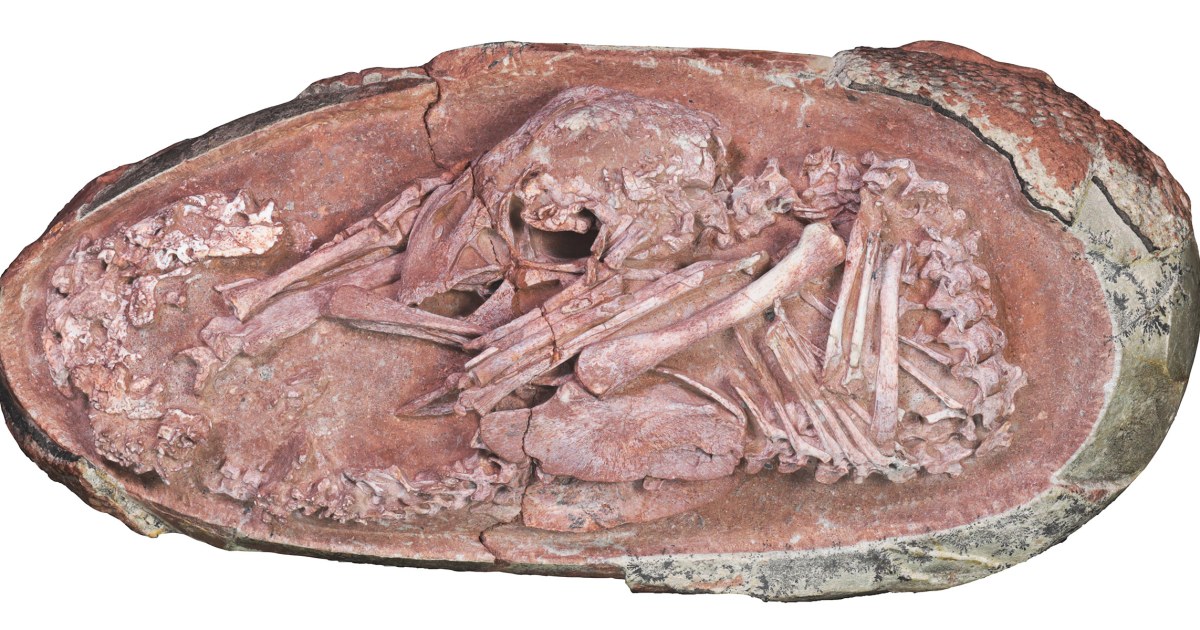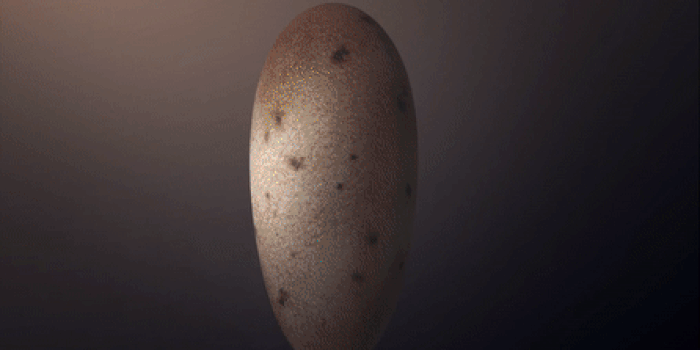
A 66-million-year-old fossil of a complete baby dinosaur in its egg, apparently just a few days before it would hatch, shows the remarkable similarities between theropod dinosaurs and the birds they would evolve into, according to a study published Tuesday.
The fossilized bones of the embryo, named “Baby Yingliang” after the museum in southern China where it was discovered, can be seen curled-up inside its 6-inch elongated eggshell and looking almost exactly like a modern bird at that stage, although it has tiny arms and claws rather than wings.
Fion Waisum Ma, a paleontologist at the University of Birmingham in the United Kingdom, said the head is particularly striking in its similarity to the head of a newly hatched bird — a resemblance heightened by a beak, called an oviraptorosaur, that was a feature of this dinosaur species. Ma is one of the lead authors of the fossil study published in the journal iScience. Scientists from China, Canada and elsewhere in the U.K. were also involved.
Oviraptorosaurs, a type of theropod dinosaur with hollow bones and three-toed limbs, were very close to the dinosaur ancestry that evolved into modern birds. As well as beaks, they had feathers on their arms. They could not fly, but there’s evidence they spread the feathers out above their nests to keep the eggs beneath them warm, said John Nudds, a paleontologist at the University of Manchester in the U.K, who was not involved in the study.
Embryonic dinosaur fossils are extremely rare — paleontologists have only found them at about half a dozen sites. And this is the first time any have shown signs of a distinctive posture known as “tucking” — with the head under the right arm — although some other dinosaur embryos have shown distinct “egg teeth” that they may have used to break out of their shells, Nudds said.
Ma said that until now the tucking posture had been seen only in birds.
“Some embryos are quite well preserved, but they don’t show this posture,” she said. “And some are very fragmentary, so it is difficult to see their posture clearly.”
Baby birds adopt the posture, with their head “tucked” under their right wing, in the egg just a few days before they hatch; and embryos that fail to get it right are seldom able to hatch properly.
Ma said tucking seems to help baby birds make their first cracks in the eggshell by restricting the movement of their head.
“It’s easier to stabilize the beak and to direct it to the same place when they try to break the eggshell,” she said.
The researchers suggest the tucking posture evolved because oviraptorosaurs had a hard shell, like those of birds, instead of a soft shell, like those of turtles — an early form of shell that was still common about 70 million years ago among dinosaurs like the sheep-sized protoceratops.
Scientists think hard egg shells gave better protection from the environment than soft egg shells, and so oviraptorosaurs and related dinosaur species may have evolved the tucking posture to break through their harder eggshells, Ma said.
Baby Yingliang was in a cache of fossils that were delivered in 2000 to the Yingliang Stone Nature History Museum in the Chinese city of Nan’an, possibly after they had been found at a construction site in the nearby city of Ganzhou.
But it wasn’t until 2015 that one of the museum staff examined the fossil egg and noticed that what appeared to be bones could be seen in a fracture.
The fossilized egg has now been scientifically analyzed, and the fossil split so that the complete skeleton of the embryo can be seen curled up in its shell.
The study suggests the fossil is 66 million to 72 million years old. The baby dinosaur would’ve been about 10 inches from beak to tail when it was hatched, and might have grown to more than 6 feet long as an adult.
Modern chicken eggs take about 21 days to hatch, although they are much smaller than this dinosaur, and scientists don’t know how long Baby Yingliang had been developing in its egg before it was fossilized. It seemed to be about to hatch within a few days, Ma said.
Many dinosaur experts have hailed the fossil as one of the best-preserved embryos they have ever seen. But some are not certain, however, that what the researchers have interpreted as a tucking posture in the embryo is actually that.
“This is an interesting discovery, but I am skeptical about the ‘tucking’ behavior as it is primarily based on a single specimen,” said Shundong Bi of the Indiana University of Pennsylvania. “I think more evidence is needed.”
Bi was not involved in the latest research but studied the fossilized remains of a different oviraptorosaur crouching above a clutch of 24 eggs, some of which contained embryos.
The interpretation of the tucking posture depended on the dinosaur egg containing a pocket of air, like the eggs of birds. But that could not be seen in this fossil and had not been seen in other dinosaur eggs, Bi said in an email.
Source: | This article originally belongs to Nbcnews.com










